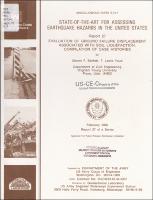Please use this identifier to cite or link to this item:
https://hdl.handle.net/11681/20727| Title: | State-of-the-art for assessing earthquake hazards in the United States. Report 27, Evaluation of ground failure displacement associated with soil liquefaction : compilation of case histories |
| Authors: | Brigham Young University. Department of Civil and Environmental Engineering Soils and Pavements Laboratory (U.S.) Bartlett, Steven F. Youd, T. Leslie |
| Keywords: | Earthquakes Earthquake hazards Earthquake risk Land spreading Soil liquefaction Soil mechanics Soil deformation Shear strength Case studies |
| Publisher: | Geotechnical Laboratory (U.S.) Engineer Research and Development Center (U.S.) |
| Description: | Miscellaneous Paper Abstract: Liquefaction induced ground failure is responsible for considerable damage to engineering structures during major earthquakes. At present, only a few empirical models exist for predicting the amount of horizontal displacement resulting from liquefaction. None of the present empirical models has fully addressed both seismic and site factors which influence horizontal displacement. The purpose of this investigation is to compile case histories of liquefaction induced ground failure and tabulate seismic, geological, topographical, and soil properties that may affect permanent horizontal ground displacement to provide a data set for the development of empirical predictive models. Case histories of lateral spreading gleaned from reports on the 1906 San Francisco, 1964 Alaska, 1964 Niigata, 1971 San Fernando, 1979 Imperial Valley, 1983 Nihonkai-Chubu, 1983 Borah Peak, Idaho, and 1987 Superstition Hills earthquakes are compiled (appendix to this report, Bartlett and Youd, 1989a). Techniques used to estimate pertinent measures that were not measured or documented in the original studies (e.g. many maximum site accelerations, strong ground motion duration, and thickness of liquefiable sediments) are also presented. Additionally, preliminary correlation regression analyses are done on the more pertinent measures to discover their value as predictor (i.e. independent) variables. The duration of strong ground motion and the thickness of the liquefied zone divided by the depth to the top of the liquefied zone are significant predictors of horizontal ground displacement at the 95 percent confidence level. Topographical factors and mean grain size also appear to influence horizontal ground displacement. |
| Rights: | Approved for public release; distribution is unlimited. |
| URI: | http://hdl.handle.net/11681/20727 |
| Appears in Collections: | Miscellaneous Paper |
Files in This Item:
| File | Description | Size | Format | |
|---|---|---|---|---|
| MP-S-73-1-Report-27.pdf | 8.27 MB | Adobe PDF |  View/Open |